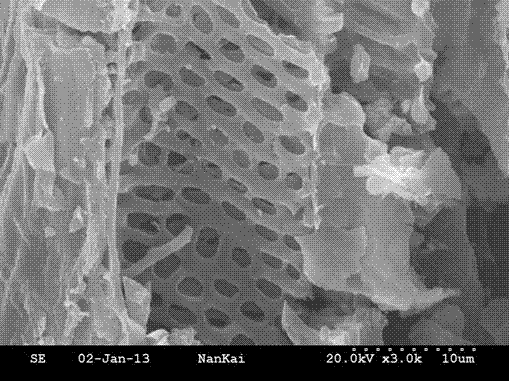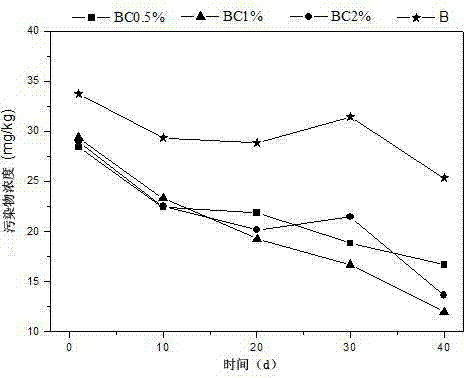A kind of remediation method of cypermethrin polluted soil
A technology of cypermethrin and polluted soil, which is applied in the restoration of polluted soil, etc. It can solve the problems of secondary pollution and difficult degradation of cypermethrin, and achieve the effect of high applicability, remarkable effect and simple operation process
- Summary
- Abstract
- Description
- Claims
- Application Information
AI Technical Summary
Problems solved by technology
Method used
Image
Examples
Embodiment 1
[0031] Select corn stalks from abundant sources as raw materials. The stalks and leaves are peeled off, washed with tap water and air-dried, initially cut and dried in an oven at 70-80°C overnight. The dried corn stalks are crushed with a crusher and passed through a 20-mesh sieve, placed in a 100mL porcelain crucible, and sealed with tin foil to avoid contact with air. Use a muffle furnace to heat anaerobically at 600°C for 1 hour, cool to room temperature and take it out. It is biochar. The microstructure of biochar is attached. figure 1 .
[0032] Weigh 7.5g of the biochar prepared and mix an equal volume of cypermethrin-free contaminated soil to prepare a soil remediation agent, then weigh 1.49kg of fresh farmland soil, pass through a 20-mesh sieve, and mix the soil remediation agent with the farmland soil. , Get 1.5kg soil mixture, that is, the mass fraction of biochar is 0.5%, put the mixed soil in the flowerpot. Cultivate in a greenhouse at 25°C, turn the soil and add wa...
Embodiment 2
[0038] Select corn stalks from abundant sources as raw materials. The stalks and leaves are peeled off, washed with tap water and air-dried, initially cut and dried in an oven at 70-80°C overnight. The dried corn stalks are crushed with a crusher and passed through a 20-mesh sieve, placed in a 100mL porcelain crucible, and sealed with tin foil to avoid contact with air. Use a muffle furnace to heat anaerobically at 600°C for 1 hour, cool to room temperature and take it out, that is, biochar.
[0039] Weigh 1.5g of the prepared biochar and an equal volume of cypermethrin-free contaminated soil to prepare a soil remediation agent, then weigh 1.485 kg of fresh farmland soil, pass through a 20-mesh sieve, and mix the soil remediation agent with the farmland soil. , Get 1.5kg soil mixture, that is, the mass of biochar accounts for about 1%, put the mixed soil in the flower pot. Cultivate in a greenhouse at 25°C, turn the soil and add water 2 to 3 times a week. Regularly collect 10g...
Embodiment 3
[0042] Select corn stalks from abundant sources as raw materials. The stalks and leaves are peeled off, washed with tap water and air-dried, initially cut and dried in an oven at 70-80°C overnight. The dried corn stalks are crushed with a crusher and passed through a 20-mesh sieve, placed in a 100mL porcelain crucible, and sealed with tin foil to avoid contact with air. Use a muffle furnace to heat anaerobically at 600°C for 1 hour, cool to room temperature and take it out, that is, biochar.
[0043] Weigh 30g of the prepared biochar and an equal volume of cypermethrin-free contaminated soil to prepare a soil remediation agent, then weigh 1.47 kg of fresh farmland soil, pass through a 20-mesh sieve, and mix the soil remediation agent with farmland soil. Get 1.7 kg of soil mixture, that is, the mass fraction of biochar is 2%, and place the mixed soil in a flower pot. Cultivate in a greenhouse at 25°C, turn the soil and add water 2 to 3 times a week. Regularly collect 10g fresh ...
PUM
 Login to View More
Login to View More Abstract
Description
Claims
Application Information
 Login to View More
Login to View More - R&D
- Intellectual Property
- Life Sciences
- Materials
- Tech Scout
- Unparalleled Data Quality
- Higher Quality Content
- 60% Fewer Hallucinations
Browse by: Latest US Patents, China's latest patents, Technical Efficacy Thesaurus, Application Domain, Technology Topic, Popular Technical Reports.
© 2025 PatSnap. All rights reserved.Legal|Privacy policy|Modern Slavery Act Transparency Statement|Sitemap|About US| Contact US: help@patsnap.com


